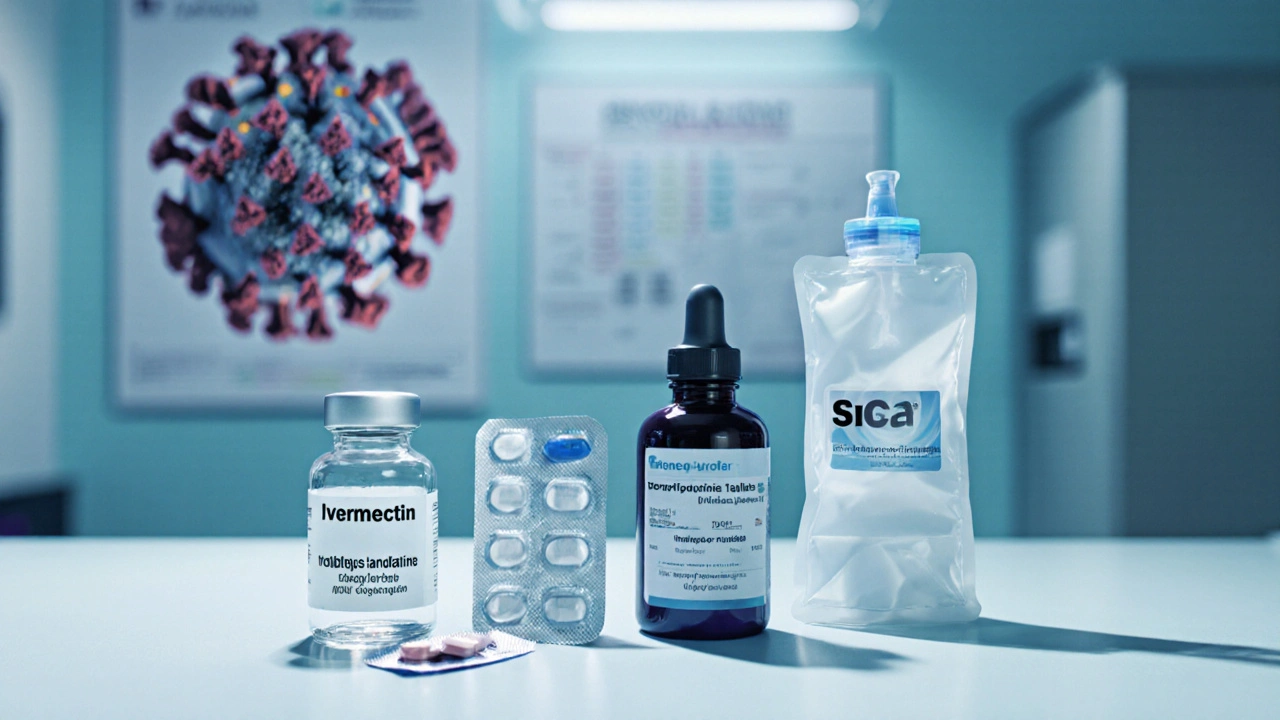Ivermectin vs Alternatives Comparison Tool
Use: Antiparasitic (approved for onchocerciasis, strongyloidiasis)
Off-label use: COVID-19 (not recommended by WHO or FDA)
Side Effects: Nausea, dizziness, rash
Severity: Mild to moderate
Use: Antibiotic with anti-inflammatory properties
Off-label use: Early outpatient COVID-19
Side Effects: Photosensitivity, upset stomach
Severity: Mild to moderate
Use: Antimalarial
Off-label use: Early COVID-19 (not recommended due to cardiac risks)
Side Effects: Headache, GI upset
Severity: Moderate
Use: Antiparasitic with antiviral activity
Off-label use: COVID-19 (limited evidence)
Side Effects: Diarrhea, abdominal pain
Severity: Mild to moderate
Use: Direct neutralization of SARS-CoV-2 spike protein
Off-label use: High-risk outpatients
Side Effects: Infusion-site reactions
Severity: Low to moderate
Clinical Evidence Summary
| Treatment | Efficacy | Safety | Availability |
|---|---|---|---|
| Ivermectin | No significant benefit for COVID-19 | Mild side effects at standard doses | Widely available |
| Doxycycline | Modest symptom reduction | Mild to moderate | Low cost, widely available |
| Hydroxychloroquine | No benefit, increased cardiac risk | Moderate risk (QT prolongation) | Limited availability due to safety concerns |
| Nitazoxanide | Preliminary positive findings | Mild side effects | Limited availability |
| Monoclonal Antibodies | Strong evidence (>70% reduction in severe disease) | Low risk (rare allergic reactions) | Expensive, requires infusion center |
Key Recommendations
- For mild cases: Supportive care is often sufficient
- For high-risk patients: Monoclonal antibodies or oral antivirals like Paxlovid are preferred
- For early outpatient treatment: Doxycycline shows modest benefit but lacks strong evidence
- For parasitic infections: Ivermectin is the standard treatment
- Always check contraindications and follow local guidelines
Quick Takeaways
- Ivermectin is an antiparasitic drug that some have repurposed for viral infections, but solid evidence for COVID‑19 treatment is lacking.
- Common alternatives include doxycycline, hydroxychloroquine, nitazoxanide, monoclonal antibodies and supportive care.
- Safety profiles differ: doxycycline can cause photosensitivity, hydroxychloroquine carries cardiac risk, while monoclonal antibodies are generally well tolerated but expensive.
- Clinical‑trial data show modest benefit for doxycycline in early COVID‑19, no clear benefit for hydroxychloroquine, and strong efficacy for certain monoclonal antibodies.
- Choosing a therapy hinges on disease severity, patient comorbidities, drug availability and regulatory guidance from the FDA and WHO.
What Is Ivermectin?
Ivermectin is a broad‑spectrum antiparasitic medication originally developed for veterinary use and later approved for human treatment of onchocerciasis, strongyloidiasis, and certain other helminth infections. It works by binding to glutamate‑gated chloride channels in parasites, causing paralysis and death. In the past few years the drug gained attention because laboratory studies suggested it could inhibit replication of some RNA viruses, sparking off‑label use for COVID‑19.
How Does Ivermectin Work?
The antiparasitic action is well documented, but its antiviral hypothesis rests on two mechanisms: (1) inhibition of importinα/β‑mediated nuclear transport, which some viruses use to hijack host cells, and (2) direct interference with viral proteins at concentrations far higher than those achieved with standard dosing. Clinical relevance of these mechanisms remains controversial.

Safety Profile of Ivermectin
At approved doses (400µg/kg for a single oral dose), Ivermectin is generally well tolerated. Common side effects include mild nausea, dizziness, and rash. Overdose can lead to neurotoxicity-confusion, seizures, and ataxia-especially when combined with other CNS depressants. The FDA has warned against using veterinary formulations for humans because of dosing uncertainties.
Key Alternatives to Ivermectin
Below are the most frequently mentioned drugs or strategies that have been compared with Ivermectin for viral respiratory infections, particularly COVID‑19.
Doxycycline
Doxycycline is a tetracycline antibiotic with anti‑inflammatory properties. It has been studied as an early‑outpatient COVID‑19 therapy because it may reduce viral load and cytokine release.
Hydroxychloroquine
Hydroxychloroquine is an antimalarial drug that was widely touted early in the pandemic. It blocks viral entry by raising endosomal pH but also carries a risk of QT‑prolongation.
Nitazoxanide
Nitazoxanide is an antiparasitic with broad antiviral activity in vitro. In a few small trials it showed faster symptom resolution, but larger studies are still pending.
Monoclonal Antibodies
Monoclonal antibodies (e.g., bamlanivimab, casirivimab‑imdevimab) are lab‑engineered proteins that bind directly to the spike protein of SARS‑CoV‑2, neutralising the virus.
Supportive Care
Supportive care includes hydration, antipyretics, oxygen therapy and, for high‑risk patients, early use of antivirals like paxlovid. It remains the backbone of treatment for mild‑to‑moderate disease when no specific drug is indicated.
Side‑Effect Snapshot
| Drug | Typical Dose | Frequent Side Effects | Serious Risks |
|---|---|---|---|
| Ivermectin | 400µg/kg PO | Nausea, dizziness, mild rash | Neurotoxicity at high dose, drug‑interaction with CNS depressants |
| Doxycycline | 100mg PO BID | Photosensitivity, upset stomach | Esophagitis, rare hepatotoxicity |
| Hydroxychloroquine | 400mg PO loading then 200mg BID | Headache, GI upset | QT‑prolongation, retinal toxicity with chronic use |
| Nitazoxanide | 500mg PO BID | Diarrhea, abdominal pain | Hepatic enzyme elevation (rare) |
| Monoclonal Antibodies | 1g IV infusion | Infusion‑site reactions | Allergic anaphylaxis (very rare) |
Efficacy at a Glance
Data from randomized controlled trials (RCTs) and meta‑analyses published up to mid‑2025 paint a mixed picture:
- Ivermectin: Large WHO‑commissioned meta‑analysis concluded no statistically significant reduction in mortality or hospitalization when used for COVID‑19.
- Doxycycline: The PRINCIPLE trial (UK) reported a modest 1‑day reduction in symptom duration when started within 5days of symptom onset.
- Hydroxychloroquine: Multiple RCTs (RECOVERY, SOLIDARITY) showed no benefit and an increased risk of cardiac events in hospitalized patients.
- Nitazoxanide: Small phase‑II studies suggest faster viral clearance, but evidence is not yet robust enough for guideline endorsement.
- Monoclonal Antibodies: Consistently show >70% reduction in progression to severe disease when administered early, though efficacy can wane against newer variants.
The WHO currently recommends monoclonal antibodies for high‑risk outpatients, doxycycline only in research settings, and advises against routine use of Ivermectin or hydroxychloroquine outside clinical trials.
How to Choose the Right Option
- Assess disease severity: Mild cases may only need supportive care; moderate to high‑risk patients benefit from early antivirals or monoclonal antibodies.
- Check contraindications: Cardiac history rules out hydroxychloroquine; liver disease cautions against nitazoxanide.
- Consider drug availability and cost: Monoclonal antibodies are pricey and may require infusion centers; doxycycline and nitazoxanide are inexpensive oral options.
- Follow regulatory guidance: The FDA has issued Emergency Use Authorizations (EUAs) for certain monoclonal antibodies but not for Ivermectin in COVID‑19.
- Monitor for side effects: Schedule ECG for hydroxychloroquine, advise sun protection for doxycycline, and watch for neuro‑symptoms with high‑dose Ivermectin.
Practical Checklist for Clinicians
- Confirm COVID‑19 diagnosis with PCR or antigen test.
- Identify patient risk factors (age>65, obesity, immunosuppression).
- Rule out contraindications for each drug.
- Discuss evidence level with patient (e.g., strong for monoclonal antibodies, weak for Ivermectin).
- Prescribe based on latest local guidelines and drug supply.
- Arrange follow‑up within 48hours to assess response and side effects.
Frequently Asked Questions
Does Ivermectin cure COVID‑19?
Current high‑quality trials and meta‑analyses show no clear benefit in reducing hospitalization or death. It may still be used for approved parasitic infections.
What is the most effective outpatient COVID‑19 therapy?
Early administration of monoclonal antibodies or oral antivirals (e.g., paxlovid) has the strongest evidence for preventing severe outcomes in high‑risk patients.
Can I take doxycycline instead of Ivermectin?
Doxycycline has shown modest symptom‑duration benefits in a few trials, but it is not a proven antiviral. Choice depends on patient tolerance and contraindications.
Are there any drug interactions with Ivermectin?
Yes. Combining Ivermectin with other CNS depressants (e.g., benzodiazepines) can increase neurotoxicity risk. It also interacts with some anti‑coagulants.
What does the WHO say about using Ivermectin for COVID‑19?
The WHO recommends against its routine use outside well‑designed clinical trials, citing insufficient evidence of benefit.


Alan Larkin
October 8, 2025 AT 15:18Looking at the efficacy column, ivermectin sits at the bottom with “no significant benefit” while monoclonal antibodies top the chart with >70% reduction in severe disease. The side‑effect severity also lines up nicely – doxycycline and nitazoxanide are mild‑to‑moderate, hydroxychloroquine lands in the moderate range because of cardiac risk, and monoclonals are low‑risk apart from occasional infusion reactions. 👀
From a cost perspective, doxycycline and ivermectin are cheap and widely available, but paying for an IV infusion of antibodies may be prohibitive for many patients. The practical takeaway is that you should match the drug to the patient’s risk profile, not the hype surrounding any single agent. In short, stick to the evidence‑based hierarchy and you’ll avoid a lot of unnecessary side‑effects.
John Chapman
October 20, 2025 AT 05:05While the tabular data is presented in a neat fashion, it neglects the nuanced pharmacodynamics that differentiate a tetracycline from a viral neutralising protein. One cannot simply equate “widely available” with “clinically appropriate” without addressing the pharmacokinetic ceiling that ivermectin never reaches in vivo for SARS‑CoV‑2. Moreover, the author’s reliance on “quick takeaways” betrays a superficial grasp of regulatory realities, especially given the FDA’s evolving EUA landscape. A more erudite analysis would juxtapose the mechanistic pathways rather than merely list side‑effects. Thus, the comparison, albeit aesthetically pleasing, falls short of scholarly rigour.
Tiarna Mitchell-Heath
October 31, 2025 AT 18:51Your comparison is a sloppy mash‑up of half‑baked data.
Katie Jenkins
November 12, 2025 AT 08:38Let’s unpack the claims one by one. First, the assertion that doxycycline offers a “modest symptom reduction” is backed by the PRINCIPLE trial, which showed roughly a one‑day decrease in median illness duration when treatment began within five days of symptom onset – that’s statistically modest but clinically tangible for some patients. Second, the table lists “limited availability” for nitazoxanide; however, it’s worth noting that several generic manufacturers have entered the market, making it more accessible than the author implies. Third, the safety profile for hydroxychloroquine is correctly flagged as moderate due to QT prolongation, yet the author omits the crucial point that routine ECG monitoring mitigates this risk in suitable candidates.
Fourth, monoclonal antibodies are indeed expensive and require infusion centres, but many health systems subsidise them for high‑risk outpatients, which changes the cost‑benefit calculus.
Finally, the disclaimer about “always consult healthcare professionals” is sound, but the guide could be strengthened by explicitly referencing the latest WHO guidelines, which discourage routine ivermectin use outside trials. Overall, the comparison is a decent starter, but the devil is in the details that the author glosses over.
Jack Marsh
November 23, 2025 AT 22:25From a formal standpoint, the presented data underscores the necessity of adhering to evidence‑based protocols rather than succumbing to anecdotal enthusiasm. The meta‑analyses cited by the WHO decisively refute any meaningful clinical benefit of ivermectin in COVID‑19 treatment, rendering its off‑label application unsupported. Likewise, hydroxychloroquine’s lack of efficacy is well‑documented, and its cardiac risks remain a contraindication in vulnerable populations. In contrast, monoclonal antibodies demonstrate robust efficacy, albeit with logistical constraints that must be addressed through health‑system planning.
Terry Lim
December 5, 2025 AT 12:11The author overlooks the cost‑effectiveness of doxycycline versus the high price tag of monoclonal antibodies. Moreover, the safety narrative is incomplete without mentioning hepatic monitoring for nitazoxanide.